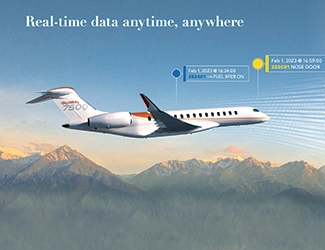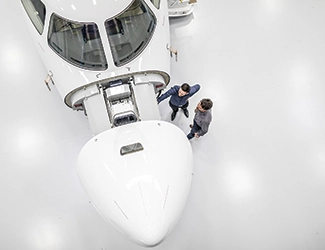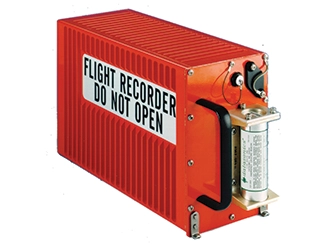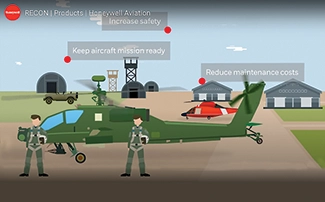Health monitoring systems
The introduction of sensors has made flight operations safer and more reliable, and has simplified maintenance.
By Owen Davies
Contributing Writer

Aircraft health monitoring systems (AHMS), aircraft health management, predictive maintenance, prognostics and health management, and health and usage monitoring systems (HUMS) are not quite the same thing, but they all grow from one idea: if you catch problems with jets and helicopters before something fails, flying will be safer and maintenance cheaper, and aircraft will spend less time on the ground. Everyone wins.
These concepts have been improving airline efficiency for more than a decade. Today, they are spreading fast through business aviation. If you are not flying an aircraft permeated with some combination of sensors and software, you will be soon.
Background
AHMS is not a new trend. Compared with jets, helicopters traditionally have had fairly dreadful readiness statistics. But this situation began to improve after GE Aerospace (then GE Aviation) released the first civil certified HUMS in 1991. Since then, GE’s Onboard Maintenance System has been installed on more than 25 helicopter types (15,000-plus units).
The current model can monitor rotor track and balance; vibrations in the rotor, engine, gearbox, shaft, and airframe; engine health and performance; limit exceedance; and a dozen other factors. It also adds a crash-protected recorder for voice, flight data, and video. Data is sent to GE’s repository in real time and is accessible at a secure website. This is a typical list of features in the HUMS market today.
AHMS for jets appeared some 20 years ago, when Airbus began delivering its Airman monitoring software. Engineers on the ground can watch all the alerts and warnings throughout the flight. For critical alerts, the work order, parts, manpower, and procedures can all be in motion before the plane reaches the ground. Otherwise, the necessary maintenance can be added to the next scheduled shop visit.
Today, Airbus also offers Skywise Health Monitoring. This Web-based system can crunch vast quantities of data, including flight reports from the past several years. That makes it possible to identify repetitive events that once might have escaped notice.
Bombardier introduced the first AHMS for purpose-built business jets in 2013. These days, the company’s Smart Link Plus AHMS collects more than 12,000 items of data from the airframe, electrical system, control surfaces, and engines, identifying maintenance items for the next shop appointment and flagging potential emergencies.

Reducing costs
Tech Mahindra, an India-based multinational that deals in the Honeywell AHMS, carried out a case study of a global aerospace firm based in Europe.
The company wanted Tech Mahindra to identify aircraft defects that could delay or cancel flights, provide ground workers with real-time information to help them get repairs ready while the plane was still in the air, and cut turnaround time for the next flight. That meant collecting data from onboard sensors and transmitting it to the ground for automated analysis.
The system they supplied improved dispatch reliability by 25 to 30%, cut person-hours needed to maintain and analyze flight data by 10%, reduced maintenance time by 10%, saved about 25% in operating costs, and improved aircraft availability by 20 to 25%.
Shift5 is a provider of predictive maintenance and cybersecurity systems based in Rosslyn VA. Although it focuses heavily on the military market, it serves civilian operators as well. Its survey of 300 operations, maintenance, and IT leaders found that airline planners expect predictive systems to reduce maintenance costs by 22%.
Those benefits have made aircraft health monitoring a big business. Industry analysts Allied Market Research put the global market at $3.58 billion in 2022 and expects it to reach $7.27 billion by 2030 – a compound annual growth rate (CAGR) of 7.65%. MarketsandMarkets estimated 2023 sales at $6.3 billion and forecast a CAGR of 6.5%, with the market reaching $8.6 billion by 2028.

Market participants
You might expect such a large and fast-growing market to attract many participants, yet most companies in this field have been serving the aviation community for years.
The largest operator of AHMS specializes in engines. This is Pratt & Whitney Canada (P&WC), whose combination of EngineWise solutions, such as Advanced Diagnostics and Engine Monitoring (ADEM) and Enhanced Flight Data Acquisition, Storage, and Transmission (eFAST), was introduced in 2017. P&WC now monitors some 10,000 aircraft using these systems.
More than 1 in 3 business aircraft use P&WC engines, including the Cessna Citation Mustang, Sovereign, and Latitude; the Dassault Falcon line, including the 6X, 7X, 8X, and the 2000 series; Embraer’s Phenom 100EV and Phenom 300E; the Gulfstream G400, G500, and G600; and the Airbus A220 bizjet conversion.
Add some obvious turboprop aircraft, such as the King Air and Super King Air, the Cessna Caravan, the Pilatus PC-12, and the Daher TBM, plus several Leonardo helicopters.
Keeping up with all these aircraft is an enormous job. The GTF engine used in the A220 generates roughly 4 million data points per flight.

10 years after
In the decade since Bombardier introduced AHMS to executive transport aircraft, other airframers have caught up. Makers of business aircraft all now offer AHMS for at least some models.
Most introduced them for their biggest, most expensive, longer-range jets first, but this technology is spreading quickly throughout product lines. Some companies can even retrofit them to earlier models. Most airframers anticipated offering AHMS for their products, so they built in the necessary sensors for future use.
Dassault’s Falcon 6X received its FAA and EASA certifications in August 2023. With a maximum range of 5500 nm and a top speed of Mach 0.90, it is the first Falcon equipped with FalconScan advanced diagnostics.
The heart of the system is an onboard server that collects and analyzes data from every system in the plane. Where the company’s previous AHMS tracked a few hundred parameters, FalconScan monitors a remarkable 100,000. It may be the most powerful AHMS yet to reach the field.
Embraer launched its Aircraft Health Analysis and Diagnosis (AHEAD) system in 2012 and gave it a radical upgrade just last year. This latest version collects data throughout the aircraft into the onboard central maintenance computer, then ships it to the company’s database and Web servers. Data is crunched in the Cloud to identify faults and detect patterns that could indicate potential issues or system degradation. This enables maintenance technicians to troubleshoot issues in near-real time.
The basic AHEAD package analyzes trends in engine parameters, pneumatics, hydraulics, landing gear, navigation instruments, and other critical systems. A premium option improves trend monitoring of flight controls, the fuel system, hydraulics, and the APU. It uses predictive analytics to forecast when maintenance tasks will be needed, so operators can plan maintenance schedules in advance.
Gulfstream’s PlaneConnect is available on models from the G500 up, and is powered by GE’s aircraft health and trend monitoring system. It can track more than 100,000 user-configured parameters for health information about engines, avionics, electrics, and other aircraft systems – although only 10,000 user-specified parameters are recorded. Data reaches ground stations via the aircraft’s communications system or GE’s wireless data network unit. Onboard storage can retain roughly 200 hours of flight data. The hardware that handles all these duties weighs a scant 4.3 lb.
Textron’s Aircraft Recording System II (AReS II) is standard equipment on newer Cessna Citation, Beechcraft, and Hawker aircraft. Unlike most business aircraft OEMs, Textron has not built its own analytical infrastructure. Instead, its LinxUs Flight Data Monitoring (FDM) program ships aircraft data to one of 3 3rd-party FDM providers.
Customers can choose analytics services from L3Harris’s Flight Data Connect platform, Safran’s Cassiopée FDM program, or ForeFlight’s CloudAhoy. All 3 provide incident monitoring and trend analysis with data-visualization software that makes it relatively easy to extract useful information from masses of aircraft or fleet data.

Rotary-wing market
Among helicopter makers, there are 2 obvious competitors, and at least one less well known provider with some impressive technology. Collins Aerospace is one of them, and the company cites 4 benefits its AHMS can deliver for small and medium-sized helicopters – early detection of incipient flaws, reduction of test flights, reduction of inspections, extended part life cycles, and faster troubleshooting.
Examples of faults detected by the system include a cracked spline adapter, a debonded tail rotor boot cuff, and sand built up in an oil cooler. The company reported that early detection cut operating costs and improved flight performance and mission readiness.
Honeywell’s latest HUMS is known as RECON. Sensors track the blades, swashplate bearing, engine compressors and accessory gearboxes, the intermediate gearbox at the aircraft’s tail, and the tail rotor. The list continues. RECON collects and processes data 8 times faster than Honeywell’s previous HUMS. And, because the system is modular, operators can pay only for what they need.
GPMS Intl got its start in 2012, when 2 engineers who had worked on the first generation of Collins Aerospace‘s HUMS joined forces. Conventional HUMS then were heavy and expensive, and they did not make it easy to acquire and transfer data.
Aiming to serve the light helicopter market, the partners simplified the equipment’s onboard architecture, integrated
Wi-Fi and cellular data transmission, and put some of the computing in the Cloud. They also devised predictive algorithms that made the best use of new smart sensors. The result, known as Foresight MX, was a lighter, cheaper, and radically more accurate health monitor for helicopters. It went into service in 2018 on the Bell 407.
The current version of Foresight MX offers rotor track and balance, flight parameters and exceedances, and a Cloud-based dashboard that enables users to check the health of parts throughout the drivetrain. It can even predict the remaining useful life of each part for predictive maintenance. It is available for Airbus, Bell, Columbia Helicopters, and MD civilian rotorcraft, plus several military models.
Looking ahead
Several new developments lie on, or just over, the horizon for aircraft health monitoring. One is the continuing adoption of defect-hiding composites in aircraft structures. This will require building ever more sensors into business aircraft and developing increasingly powerful data transmission and analysis systems to handle their output.
Even without that growing demand for data capacity, communications systems will require periodic upgrades as telecoms roll out 5G and faster technologies. A year ago, they were already working on 8G communications. If they are not yet up to 9G, they soon will be.
Yet the most transformative development will be the one already changing the rest of society – the rise of artificial intelligence (AI). Already, several airframers are touting the machine-learning software built into their AHMS. In the next 5 years, vastly more powerful AI will bring greater analytical power and convenience to aircraft health monitoring. It will identify problems before today’s software can, summarize its findings in natural conversation, optimize maintenance planning even more successfully than current AHMS, and further streamline fleet operations.
And, contrary to the fears of some AI skeptics, tomorrow’s health monitoring systems will never tell you,
“I’m sorry, Dave. I’m afraid I can’t do that.” For bizjet operators and the professional pilots who fly their aircraft, the rise of AI will make executive aviation safer, more convenient, and more reliable. It will be an unmitigated win for pilots, operators, and passengers alike.
 Owen Davies is a veteran freelance writer specializing in technology. He has been a futurist at Forecasting International and TechCast Global.
Owen Davies is a veteran freelance writer specializing in technology. He has been a futurist at Forecasting International and TechCast Global.